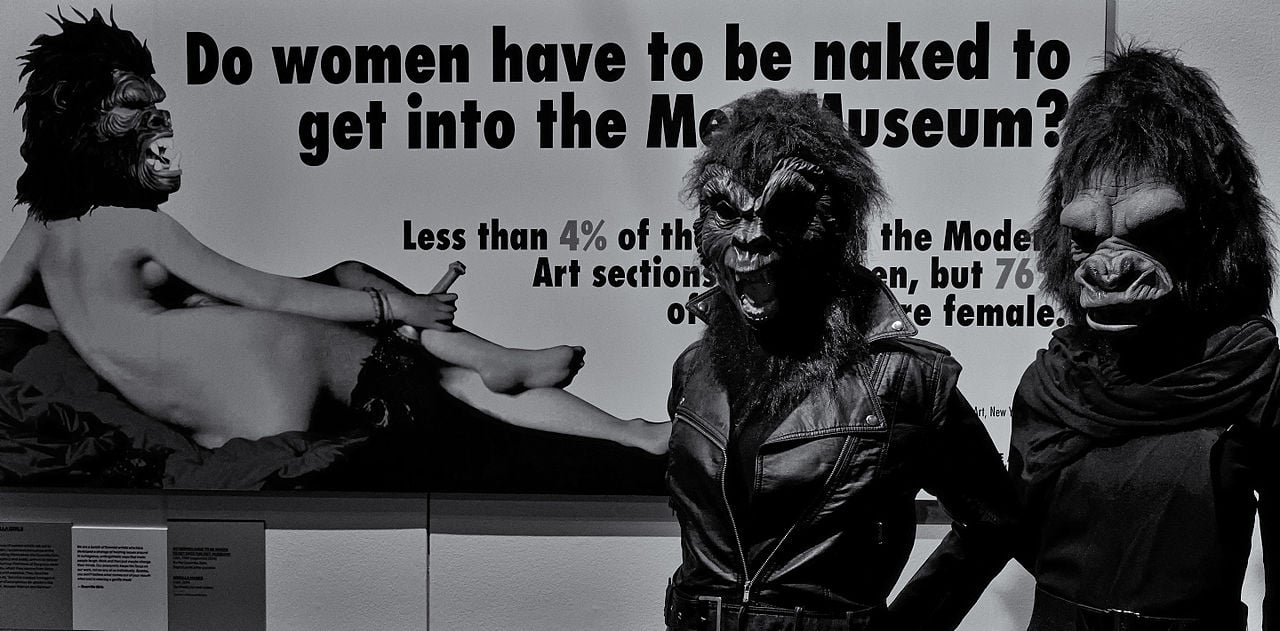Last week I went to the Ashmolean to see the exhibition Degas to Picasso: Creating Modernism in France, from 1800 to the mid-twentieth century. There was one mention of a female painter, Berthe Morisot, and an almost overwhelming focus on the female body. The female form was undeniably a preoccupation for the Impressionists and for the Picasso. But the exhibition made me wonder, as I do after seeing most exhibitions, why is art history still overwhelmingly about white male artists and their concerns? Where was even a passing reference to a painting by and not of a woman?
The Ecole des Beaux-Arts didn’t admit women in until 1897. But this didn’t mean that they had no impact on the creation of ‘Modernism’. The exhibition reminded me of the Guerrilla Girls poster, made in 1989, which reads “Do women have to be naked to get into the Met. Museum? Less than 5 per cent of artists in the Modern Art sections are women but 85 per cent are nudes of them.” The statistic might have changed but only infinitesimally: in 2011 the National Gallery held 2,300 works of art, eleven of which were made by women.
Guerrilla Girls rephrased the question ‘why haven’t there been more great women artists in Western history?’ as ‘why haven’t more women been considered great artists throughout Western history?’. I still ask myself that question—and it’s not only of Western history. Most people have heard of Michelangelo but who knows anything about Sonfonisba Anguissola? Who has read about Lygia Pape or Mary Cassatt?
The majority of art graduates are female but that is in no way reflected by the presence of female artists in galleries. It also becomes more specific than just gender: the art world still patronises women who have children, for example. Female art museum directors earn less than their male counterparts and although they run 42.6 per cent of museums in the US, these are most usually the ones with smaller budgets.
A painting by Georgia O’Keeffe—known, incidentally, as ‘the mother of American modernism’—entitled ‘Jimson Weed/White Flower No. 1’ (1932) sold for $44.4 million at Sotheby’s in 2014, breaking the record for the most expensive art work by a female artist ever sold. The most expensive art work by a male artist ever sold was over double that price.
Female art is worth less, not just economically, but culturally. It’s not important enough to devote solo exhibitions to, and is often not even entrusted to female hands. Carmen Herrera wasn’t seen as comparable to Ellsworth Kelly or Barnett Newman when she was painting as part of the US School. The work of Plautilla Nelli has never been comparable to Caravaggio’s.
The art world seems to be changing: the Uffizi Gallery is exhibiting Nelli’s work in a solo exhibition this year, as well as showing Maria Lassnig in the Pitti Palace from March. The Prado in Madrid is for the first time holding a solo show for a female artist, Clara Peeters, this year. Suddenly, maybe, you could dare to think that a painting by a female is worth as much as a male’s.
In 2015 the Tate Modern held three solo exhibitions by women: Sonia Delaunay, Agnes Martin and Marlene Dumas. Somehow, I managed to see them all. The bold black print announcing their names on the walls of the gallery and the vibrancy of Delaunay’s paintings held infinite promise. Yet artists such as Eileen Cooper and Phoebe Boswell (speaking on Radio 4 this week) still stress the importance of all-female or all-female and all-black exhibitions, emphasising the importance of spaces in which art can be valued for its own sake, and not be reduced by the fact that it wasn’t painted by a man.
Some of my favourite artists just happen to be female: Frida Kahlo, Cornelia Parker, Rose Wylie, Louise Bourgeois, Sonia Delauney, Zarina Bhimji, and Emily Kame Kngwarreye, for example. Their work is not less worthy of gallery space, but should be seen as having inestimable value, as they do for me. “Museums in general mirror the power structures in our society, structures that in the arts for example privilege the history of white men’s achievements”, argues Susan Fisher Sterling: they act as microcosms for our divided society. But they are also structures that continually show art that speaks truth to power, that create new spaces for the unsaid, the forgotten, the overlooked.
They should question the narratives we have been taught: the narrative that women can’t create art that holds any value next to the art of a man, the narrative that women weren’t there while the world was changing, that they had no role to play in its transformation.



